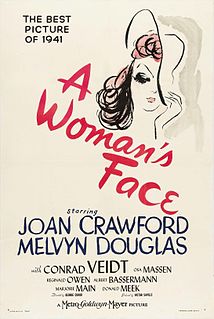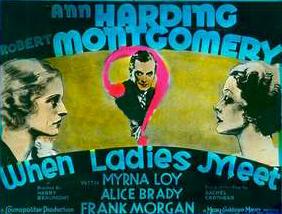
Joan Crawford was an American actress. Starting as a dancer in traveling theatrical companies before debuting on Broadway, Crawford was signed to a motion picture contract by Metro-Goldwyn-Mayer in 1925. Initially frustrated by the size and quality of her parts, Crawford began a campaign of self-publicity and became nationally known as a flapper by the end of the 1920s. In the 1930s, Crawford's fame rivaled MGM colleagues Norma Shearer and Greta Garbo. Crawford often played hardworking young women who find romance and financial success. These "rags-to-riches" stories were well received by Depression-era audiences and were popular with women. Crawford became one of Hollywood's most prominent movie stars and one of the highest paid women in the United States, but her films began losing money and by the end of the 1930s she was labeled "box office poison".
Madame Curie is a 1943 American biographical film made by Metro-Goldwyn-Mayer. The film was directed by Mervyn LeRoy and produced by Sidney Franklin from a screenplay by Paul Osborn, Paul H. Rameau, and Aldous Huxley (uncredited), adapted from the biography by Ève Curie. It stars Greer Garson, Walter Pidgeon, with supporting performances by Robert Walker, Henry Travers, and Albert Bassermann.
The year 1946 in film involved some significant events. The Best Years of Our Lives, released this year, became the highest-grossing film of the 1940s, and went on to win seven Academy Awards, including Best Picture, Best Director and Best Actor.

Rita Hayworth was an American actress, dancer and producer. She achieved fame during the 1940s as one of the era's top stars, appearing in 61 films over 37 years. The press coined the term "The Love Goddess" to describe Hayworth after she had become the most glamorous screen idol of the 1940s. She was the top pin-up girl for GIs during World War II.

Gwyllyn Samuel Newton "Glenn" Ford was a Canadian-American actor who often portrayed ordinary men in unusual circumstances. Ford was most prominent during Hollywood's Golden Age as one of the biggest box-office draws of the 1940s, 1950s, and 1960s, who had a career that lasted more than 50 years. Although he played in many genres of movies, some of his most significant roles were in the film noirs Gilda (1946) and The Big Heat (1953), and the high school angst film Blackboard Jungle (1955). However, it was for comedies or westerns which he received acting laurels, including three Golden Globe Nominations for Best Actor in a Comedy movie, winning for Pocketful of Miracles (1961). He also played a supporting role as Clark Kent's adoptive father, Jonathan Kent, in Superman (1978).

Born Yesterday is a 1950 American comedy-drama film directed by George Cukor, based on the 1946 stage play of the same name by Garson Kanin. The screenplay was credited to Albert Mannheimer. According to Kanin's autobiography, Cukor did not like Mannheimer's work, believing it lacked much of the play's value, so he approached Kanin about adapting a screenplay from his own play. Because of legal entanglements, Kanin did not receive screen credit.

Rachel Crothers was an American playwright and theater director known for her well-crafted plays that often dealt with feminist themes. Among theater historians, she is generally recognized as "the most successful and prolific woman dramatist writing in the first part of the twentieth century." One of her most famous plays was Susan and God (1937), which was made into a film by MGM in 1940 starring Joan Crawford and Fredric March.

Rain is a 1932 pre-Code drama film that stars Joan Crawford as prostitute Sadie Thompson. Directed by Lewis Milestone and set in the South Seas, the production was filmed in part at Santa Catalina Island and what is now Crystal Cove State Park in California. The film also features Walter Huston in the role of a conflicted missionary who insists that Sadie end her evil ways, but whose own moral standards and self-righteous behavior steadily decay. Crawford was loaned out by MGM to United Artists for this film.

Jean Louis was a French-born, Hollywood costume designer and an Academy Award winner for Best Costume Design.

Holiday is a 1938 American romantic comedy film directed by George Cukor, a remake of the 1930 film of the same name. The film tells of a man who has risen from humble beginnings only to be torn between his free-thinking lifestyle and the tradition of his wealthy fiancée's family. The film, adapted by Donald Ogden Stewart and Sidney Buchman from the 1928 play of the same name by Philip Barry, stars Katharine Hepburn and Cary Grant and features Doris Nolan, Lew Ayres, and Edward Everett Horton. Horton reprised his role as Professor Nick Potter from the 1930 version.

The Caretakers is a 1963 American drama film starring Robert Stack, Polly Bergen, Diane McBain, Joan Crawford and Janis Paige in a story about a mental hospital.

No More Ladies is a 1935 American romantic comedy film directed by Edward H. Griffith. The film stars Joan Crawford and Robert Montgomery, and co-stars Charlie Ruggles, Franchot Tone, and Edna May Oliver. The screenplay credited to Donald Ogden Stewart and Horace Jackson is based on a stage comedy of the same name by A.E. Thomas.

A Woman's Face is a 1941 American drama film directed by George Cukor and starring Joan Crawford, Melvyn Douglas and Conrad Veidt. It tells the story of Anna Holm, a facially disfigured blackmailer, who because of her appearance, despises everyone she encounters. When a plastic surgeon corrects this disfigurement, Anna becomes torn between the hope of starting a new life and a return to her dark past. Most of the film is told in flashbacks as witnesses in a courtroom give their testimonies. The screenplay was written by Donald Ogden Stewart and Elliot Paul, based on the play Il était une fois... by Francis de Croisset. Another version of the story, a Swedish production, was filmed in 1938 as En kvinnas ansikte, starring Ingrid Bergman.

When Ladies Meet is a 1933 pre-Code film directed by Harry Beaumont and starring Ann Harding, Myrna Loy, Robert Montgomery, Alice Brady, and Frank Morgan. The film is the first adaptation of the 1932 Rachel Crothers play of the same name. It was nominated for an Academy Award for Best Art Direction by Cedric Gibbons.

When Ladies Meet is a 1941 American romantic comedy film by Metro-Goldwyn-Mayer starring Joan Crawford, Robert Taylor, Greer Garson, Herbert Marshall, and Spring Byington in a story about a novelist in love with her publisher. The screenplay by S.K. Lauren and Anita Loos was based upon a 1932 play by Rachel Crothers. The film was directed by Robert Z. Leonard, who also co-produced the film. The film was a remake of the 1933 pre-Code film of the same name, which starred Ann Harding, Myrna Loy, Robert Montgomery, and Frank Morgan in the roles played by Garson, Crawford, Taylor and Marshall.

The Women is a 1939 American comedy-drama film directed by George Cukor. The film is based on Clare Boothe Luce's 1936 play of the same name, and was adapted for the screen by Anita Loos and Jane Murfin, who had to make the film acceptable for the Production Code for it to be released.

Her Cardboard Lover is a 1942 American comedy film directed by George Cukor, starring Norma Shearer, Robert Taylor, and George Sanders. The screenplay by Jacques Deval, John Collier, Anthony Veiller, and William H. Wright is based on the English translation of Deval's 1926 play Dans sa candeur naïve by Valerie Wyngate and P.G. Wodehouse.

Fred Astaire and Ginger Rogers were dance partners in a total of 10 films, nine of them with RKO Radio Pictures from 1933 to 1939, and one, The Barkleys of Broadway, with MGM in 1949, their only color film.

The Scarlett O'Hara War is a 1980 American made-for-television drama film directed by John Erman. It is based on the 1979 novel Moviola by Garson Kanin. Set in late 1930s Hollywood, it is about the search for the actress to play Scarlett O'Hara in the much anticipated film adaptation of Gone with the Wind (1939). This film premiered as the finale of a three-night TV miniseries on NBC called Moviola: A Hollywood Saga.

Girls Can Play is a 1937 American drama film, directed by Lambert Hillyer. It stars Julie Bishop, Charles Quigley, and Rita Hayworth.


















